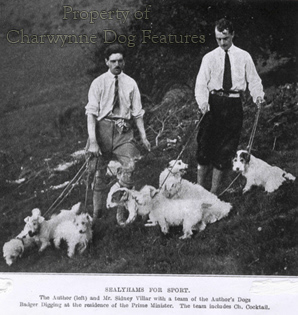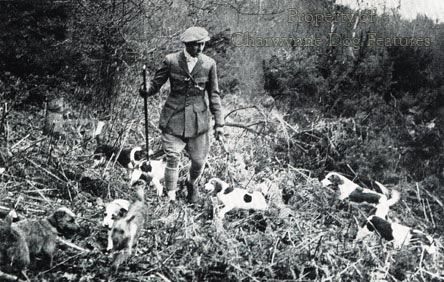693 Bobbery Packs
JOY FROM A BOBBERY PAC
by David Hancock
 “The pack was mixed, consisting partly of foxhounds drafted from other kennels to save a yard of rope – these were the intended mainly for show; partly of a miscellaneous assortment of breeds, among which a basset-hound seemed to have taken the leading part. These last were relied on to do the work, particularly old Trueboy, an ancient hero of uncertain origin, whose unerring scent and mellow tone proved of incalculable value to his less gifted brethen.” Those picturesque words by HR Heatley come from a piece entitled ‘A Bobbery Pack’, contained in The Badminton Magazine of 1901, and sum up very succinctly the essential elements of such a group of sporting dogs.
“The pack was mixed, consisting partly of foxhounds drafted from other kennels to save a yard of rope – these were the intended mainly for show; partly of a miscellaneous assortment of breeds, among which a basset-hound seemed to have taken the leading part. These last were relied on to do the work, particularly old Trueboy, an ancient hero of uncertain origin, whose unerring scent and mellow tone proved of incalculable value to his less gifted brethen.” Those picturesque words by HR Heatley come from a piece entitled ‘A Bobbery Pack’, contained in The Badminton Magazine of 1901, and sum up very succinctly the essential elements of such a group of sporting dogs.
In his English Fox Hunting, A History, of 1976, Raymond Carr has written of the ‘scratch’, farmer’s and City packs: “When no local landlord took the lead, farmers and local tradesmen formed their own packs. This was the case in Essex where there were few aristocratic packs but a collection of farmers’ and village packs – the Invincibles, the Talents.” He quotes Beaufort and Morris’s book Hunting as stating “The hounds were kept anyhow, having a butcher for one master, a baker for another, a farmer for a third, spreading pretty well through the village.” There is very little documented history of such packs, but what fun they must have provided.
The British have long favoured hunting with small packs of hunting dogs, wherever they lived, at home or overseas. Pierce O’Conor, in the 1920s, Jocelyn Lucas, in the 1930s and 40s, Ivester Lloyd in the 1950s and Brian Plummer thereafter, all hunted mixed packs if mainly terrier-based. In a previous century, Sir Samuel Baker used a composite pack of ‘staghound, bloodhound and Manila bloodhounds’ to hunt elk and other big game in what was then Ceylon; George Sanderson used a collection of Bull Terriers, half-bred Bulldogs and prototypal Bullmastiffs to hunt bear and other prey in India. Early in the last century, big game hunters in Africa like Rainey and Shelley used mixed packs of Plott Hounds, Airedales and cattle dog crosses with some success. In India, EL Lyon had considerable success with his brindle Bull Terriers (of the Staffordshire type) and ‘long-dogs’, crossbred kangaroo dogs from Australia, in the hunting field in the 1890s, when most garrisons had their own bobbery pack.
Much more recently, in New Zealand, hunters of feral pig like Kim Swan, have used cross-bred dogs of very mixed ancestry, but with considerable success, favouring the use of huntaway blood, bull blood (mainly Bullmastiff) and Bull Terrier cross Australian Cattle Dog hybrids. In Kenya, in the pre-second world war period, Major Doig was hunting jackal with a terrier pack with pedigrees going right back to Russell’s Tip and Trump. The dogs used related both to prey and country. The Earl of Listowel had four experienced hunting dogs he used on wart-hog; each dog specialized: one going for the right ear, another for the left, a third went for the snout and the fourth hung on to the tail, but each one picked those same positions each time a wart-hog was engaged. Once they had settled into this system, the dogs kept to it. 
In the wake of the Hunting with Dogs Act, an even greater need for vermin-control could lead to the increased licensing of small operators, using dogs and guns, to reduce fox and rabbit numbers in specified areas. However unsatisfactory in the round, it could see in the longer term a return or revival of 'bobbery packs', usually collections of small hounds and terriers, or even spaniels, to drive legal quarry/vermin to the waiting guns. Having read Roger Free's 'Beagle and Terrier' as a fourteen year old, hunting with a small pack of assorted dogs, has long appealed to me. He wrote in times when individual freedom had greater respect but a future need for vermin-control could see his style of operating in the field on the way back and to a greater degree. The remarkable Sir Jocelyn Lucas used to hunt with his renowned Ilmer pack of Sealyhams (and before that a pack of smooth Fox Terriers); he wrote that he didn't want a dog that becomes tired after walking a mile and lamented the "most appalling-looking terriers described as 'working type'." There is no need for a bobbery pack, however nondescript, to feature unsound dogs or ugly brutes.
In his informative "Secrets of Dog Training" Brian Plummer writes, with deliberate understatement, "Terriers despite their small size, are sometimes far from easy to control. In addition to the fact that most terriers still retain a strong inclination to hunt any type of animal or bird whose scent crosses their paths, the majority are particularly eager to take offence from another dog." It is interesting to note that most experienced and well-regarded terrier-men dislike dogs that are too hard; many outspoken but less experienced working terrier fanciers will often boast of the sheer aggression in their dogs. This to me is a sure sign of ego overcoming common sense.
Writing in his valuable book, Hounds, Hunting and Country, Derrydale Press, 2001, Newton Rycroft describes hearing of a Mr Nevill in Hampshire, who hunted rats in the turnip fields and nearby hedges, with lighter, smaller almost black Bloodhounds, and reacting by trying it with his Beagles. “I picked two couples of the smallest and most varminty I had…I then added a terrier, a charming little broken-coated bitch that had come from the Vine kennels…At first the beagles were somewhat shy of tackling an old rat, but the terrier soon taught them how to kill and they became quite proficient at it. I loved it!” There is the value of a mixed pack and the blending of instinctive skills in the hunting field.
A breed very rarely used here in Britain for sporting purposes but found valuable overseas is the Airedale. Perhaps it was a mistake to call this breed a terrier; in France it would have been called a griffon, and expected to hunt the bigger game. The Airedale is appreciated much more in the United States as a working dog than here, the country that produced it. Nearly twenty years ago the first annual Hunting/Working Workshop of the Airedale Club of America was held. This workshop planned events to prove that the Airedale could still be a versatile hunting dog. In three days, on the Killdeer Plains Wildlife Area near Marion, Ohio, the Airedales were tested in: upland bird hunting, trailing and tracking fur and then retrieving. 
Then the North American Working Airedale Terrier Association was formed with these goals: to improve the physical soundness and temperament of the breed, to participate in Schutzhund or protection dog training, to promote tracking events and other working tests. I know of no such tests in Britain. For anyone forming a bobbery pack for rabbit-hunting, the Airedale would be a good choice. I wonder though just how dormant the hunting instinct is after a century of neglect. The breed was developed to combat the prevalence of pine-martens (now being reintroduced), polecats and otter in the Aire Valley around 1850. I believe that some working Airedales have now been imported from the USA and are at last being hunted here once more; that is such good news.
In his admirable and informative book on Beagles, of 1974, Courtney Williams wrote: “No history of hare-hunting would be complete without reference to the many bobbery packs which flourished in all parts of the country during the eighteenth and nineteenth centuries. As a rule, they were communally owned and trencher-fed, hunting anything they could find, but more especially hare, fox, or outlying deer. With hounds of many breeds and divers sizes, some of these packs showed good sport…Packs of this sort are still common enough in Ireland; there may be an odd one or two in Wales and in the north, but from England itself, they have disappeared, except, of course, for those ‘packs’ of Sealyhams or dachshunds which are sometimes used for chasing rabbits. On the whole, I feel that the passing of the bobbery pack is perhaps a matter for regret.” For me, it is more than a matter of regret, it is a truly sad loss from our sporting scene.
It is therefore so good to learn from Hounds magazine’s readers’ columns that the “Wormstall Rabbit Hounds”, formed in 2005 to hunt rabbits by three very young teenaged enthusiasts, who organize the meets, country and meet cards. Their hounds are a mixture of spaniel X Jack Russells, a couple of Beagles and a lurcher. Their welcome initiative and admirable enterprise is an inspiration to all who value our country sports and look to the young to supply future impetus.
In his 'The Dog in Sport' of 1938, J Wentworth Day wrote: "Nobody shoots rabbits on sunny Sussex downlands with such packs of slow and musical beagles in these hurried days. We hurry so much we miss the half of life, the charm of quiet things, the simplicity of the easily attainable." Roger Free knew of the charm of quiet things and found them easily attainable. If packs of hounds ever have to be dispersed, a hunting future in bobbery packs would be one way of employing the best bred dogs in Britain -- and perpetuating their ingrained skills. Perhaps those fattening their wallets but missing the best of life, in the City, should now be seeking a country property and a dozen sporting dogs to restore their sanity. In so doing they would be going down a well-worn and rewarding trail. There is sheer sporting joy in hunting with bobbery packs!